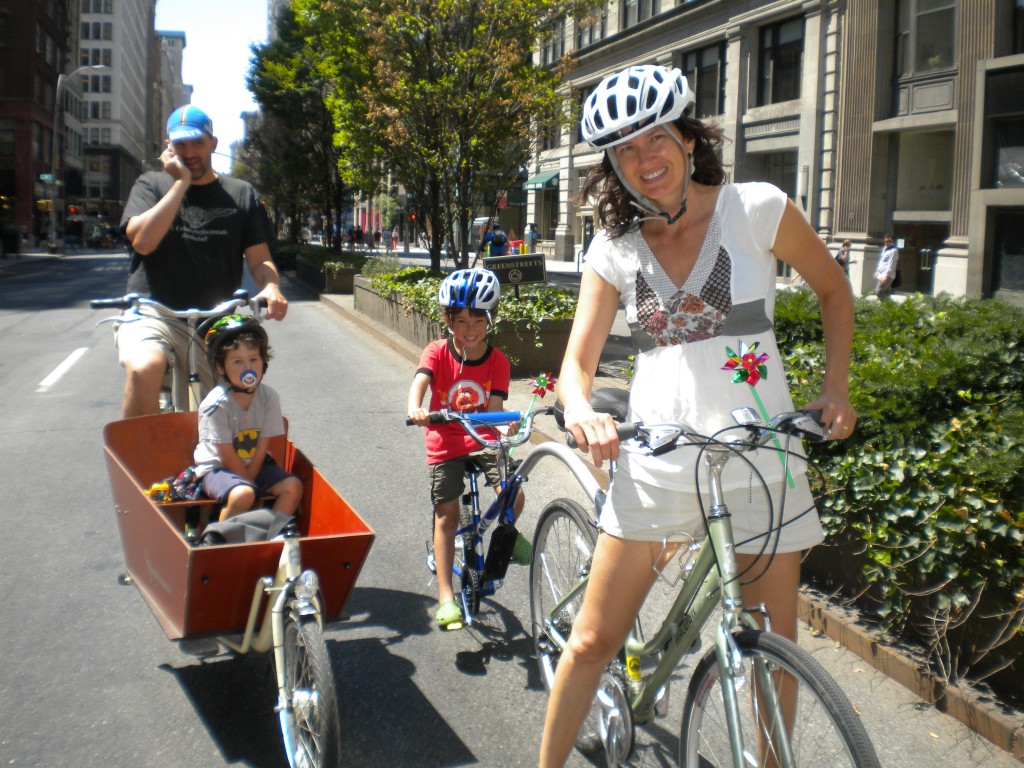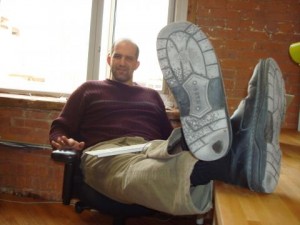
Aaron and family. Photo by Clarence Eckerson via StreetFilms.org.
In the past decade, New York City has seen a remarkable transformation from one of America’s worst bike cities to one of its most progressive. Like any political movement, the change was a confluence of many, many factors. And Aaron Naparstek seems to have had his hands in a whole lot of them. From Honku–a neighborhood campaign centered on haiku about traffic–to work with Transportation Alternatives to founding StreetsBlog, he has played an important role in New York City’s evolution towards walkable, bikeable, livable streets.
In part one of this far-reaching interview, Aaron discussed his current work as a MIT Visiting Scholar and his recent Loeb Fellowship at Harvard, his roots in neighborhood activism and streets advocacy, and the foundation and growth of StreetsBlog, an influential advocacy journalism outlet in the livable streets movement. Part two continues with our discussion of pivotal moments in the history of New York City’s bike advocacy, the work necessary to continue its growth as a bike-friendly place, and the successes and shortcomings of modern American bike advocacy at large.
You witnessed and played a role in NYC’s transformation from a city hostile to bikes to one with some of the best bike infrastructure in the country. What were some of the defining moments that brought about that change?
That’s such a good question. I actually want to write a book about this very topic. I think it’s a really fascinating story. There are so many different things. One thing that doesn’t get enough credit–or maybe it does and I just don’t hear it–the Internet was a really big moment.
The advent of social media and the Internet as a tool for organizing really changed advocacy and made the movement happen in a high-impact way. Even as late as the mid 90s, if you wanted to let people know about a community meeting that was really important to some new bike project, you basically had to go around and put cards in the spokes of bikes parked in the neighborhood where this thing was happening. You had to use Transportation Alternative’s phone tree. Someone would call me. Then I would have 10 people to call, then those people would each have 10 people to call to let know about the meeting. Really archaic ways of organizing and group coordination.
Then only a few years later when social media tools emerged, you could all of a sudden put that same notice up with the Twitter hashtag #bikeNYC and retweet it around and reach 10,000 people. Or you could put a post up on StreetsBlog that reaches 10,000 people instantly. The Internet fundamentally drove down the cost of advocacy and organizing and massively amped up the campaigning we were doing. You talk to John Kaehny, Executive Director of TA before Paul, he had to work so much harder to do the same amount of messaging.
The Internet also helped with the exchange of ideas. Clarence and I could go down to Bogota, Colombia and do a film about Ciclovia and that StreetFilm could then zip around the country over the next five years. Things just stay on the Internet and can be found again. Now the mayor of San Francisco is able to look at this little video and say “we should do that.” And the mayor of Baltimore and I think mayors in seven other cities who saw the Ciclovia video. Advocates got the video in front of their decision makers and were able to create car-free weekend events.
The second thing I’d say is the New York City Streets Renaissance Campaign. It was really key. People don’t really know that much about it, but it was a really brilliant, far-reaching campaign. Mark Gorton deserves tons of credit for this. Mark is a really big-picture thinker and he was asking all the different advocates of New York City to start thinking about a more transformative vision. When you’re an advocate you need to get wins. Sometimes that sort of forces you into thinking small, especially if you’re fighting a really bad bureaucracy. You find yourself fighting for a speed bump in front of a school or a class three sharrow on an avenue where a cyclist just got killed. And it’s bullshit. You spend a huge amount of your life and that’s what you win. Mark was like “screw that. Let’s put forth a much bigger vision for New York City streets.” And that’s what the Campaign did for a lot of different means. One of the most powerful means, again amped up by the Internet, was the photo simulations we were producing. They showed what your street looks like now and here’s what it could look like if it was a livable street. It showed people a new vision.
When the Campaign and StreetsBlog and StreetFilms emerged in 2006 it was kind of remarkable. I didn’t think it would work. I thought I better apply to grad school or something because I imagined it would only last for a few months then I’d be out of a job. But pretty quickly, with the advent of StreetsBlog, I started hearing about things like Deputy Mayor Doctoroff getting in a screaming match with DOT Commissioner Weinshall at City Hall and a lot of people saw it. He’s getting really upset with her that she’s dragging her feet on these changes. StreetsBlog and the Campaign helped create a new set of expectations about how a city DOT should operate.
That eventually led to Iris Weinshall finding a new job and the really big, important change: Janette Sadik-Khan taking her place. I think maybe it’s not emphasized enough the fact that her most brilliant move, frankly, was to bring in the management team she brought it. They were almost all selected from this advocacy community. People like Jon Orcutt, Bruce Schaller, Daniel Simons, Andy Wiley-Schwartz. And there were already a lot of talented people in the lower levels of DOT who were being stymied by Weinshall and her chief engineer.
Janette popped the cork on the champagne bottle. There was all this energy all of sudden. New York streets had been frozen in time for 50 years in this 1950s, car-oriented mindset. These young planners in the middle levels of the bureaucracy, they’d been to progressive planning schools and were of the 21st century. They knew what was happening in Bogota and Paris and London and Seoul and they wanted to see those things happen in New York. As soon as someone let them do it, they went to town. Literally.
Despite that progress, bicycling still makes up a very small percentage of the mode share in the city. 2013 Census numbers say about 1 percent. What needs to happen to ensure continued growth?
First of all, Census data is problematic for a number of reasons. If you look neighborhood to neighborhood at mode-share, biking is pretty high in some spots. It’s up into the 5-, 6-, 7-percent range in places like Williamsburg, Park Slope, parts of lower Manhattan. You can see it. There are more people biking in New York. Though that is still a relatively small number, obviously.
I think the bike share program is where it’s at in terms of mainstreaming and increasing the number of bikes in New York City. The interesting thing about bike share is it really started to move a new population onto bicycles. Anecdotally, last summer and fall you’d see a lot more people wearing suits and nice business clothes making crosstown trips. You’d see a lot more women. A lot more people of color. You’d see the broad spectrum of New York City on these bike share bikes. Advocates and DOT people would agree with this, bike share is probably going to be the thing that drives demand for better infrastructure as well.
At the end of Janette’s tenure we had, to some extent, maxed out the city’s willingness to keep building up bike infrastructure quickly. But now there’s a new population coming onto bikes and demanding safe infrastructure. And that population is a much more mainstream group. Not bike advocates. Not environmentalists. Just guy from the office, gal from the office who wants to make a crosstown trip safely on one of these new bikes. That’s going to be a really powerful source of advocacy. I think we’re already seeing it. DOT is pushing forward with some projects in Midtown now.
Vision Zero is really key as well. Unfortunately there has been a spate of really horrible child fatalities on New York City streets. There’s daily carnage, which is one of the things I always really wanted to highlight on StreetsBlog. Why do we assume this is acceptable business as usual; this amount of damage and destruction from cars? I always thought that was bizarre, and even more bizarre that people in power didn’t seem to care. So Vision Zero is another thing driving change right now and its huge. The fact that there are these parents of child fatalities who are as diverse as New York City and from all five boroughs, or at least four. They’re a powerful new force in advocacy that are going to really help move things forward.

These days there are enough people riding bikes in New York that you get something of a bike rush hour according to Bike Snob NYC. Photo by Eben Weiss.
Looking at American bike advocacy as a whole, what do you see happening right now around the country that’s working really well?
I think the most interesting thing is the emergence of something I’m calling the red-state urbanist. Chuck Marohn of Strong Towns is probably the most prominent example. The mayor of Oklahoma City, Mick Cornett, he’s a Republican. The guys who do Better Block, Andrew and Jason, are from Dallas, Texas. Most of their work is in really conservative, smaller towns in very red-leaning states. This desire for walkable, bike-friendly, transit-oriented urbanism is starting to spread beyond your big coastal, liberal cities. It’s starting to find audiences and appeal in places that are traditionally much more conservative. That’s potentially a really powerful new part of this movement.
It never made sense to me that Republicans would just hate a walkable place or a bike-friendly place. If you take the political party’s values at face value, self-reliance and fiscal responsibility and freedom, those are the values of biking. We don’t need $100 million interchanges built out in cornfields. That’s fiscally irresponsible. Wasted government funding and reliance on foreign oil and big corporations and all this other crap. The move to reinvigorate smaller towns and engage people in this idea of tactical urbanism–just going out on the street and not waiting for government to make your street better–these are ideas that should be very appealing to a lot of conservatives. And Better Block and Strong Towns are showing that a lot of these ideas are appealing to conservatives. That’s the most interesting thing going on right now.
On the flip side of that, what do you wish American bike advocates would stop doing?
It’s hard to generalize, because advocacy is so local. Every city and town is in a different place in their evolution towards bike friendliness, which I do think is an inexorable evolution. But in New York, I feel like it’s time to move on from ghost bikes. I don’t like that project anymore. I get it. I do see that there’s value to it. I loved it when I first encountered it and thought it was incredibly powerful. But, in recent years I’ve had a number of friends on the older end of the spectrum who’ve never ridden bikes before. They want to try it, but see all these ghost bikes and they’re like “these things scare the crap out of me.” It makes them think biking is too dangerous to try. To me that’s not good advocacy anymore. Whenever I say that it really upsets people. I’ve helped install ghost bikes. A woman in my neighborhood was killed and I called up the ghost bike guys to get a ghost bike in that spot. But, at least in New York I would not mind seeing that fade away or be replaced with something else.
In San Francisco, I’ve heard people say similar things about critical mass. It’s just making people angry. These tactics might’ve been really good 10 years ago. But your bike culture moves to a certain place and now maybe that tactic is not as powerful as it once was. I don’t want to just pick on critical mass and ghost bikes because they still really have their place. Maybe not where they originated, but in new places.
Like what you read on The Bicycle Story? Support the work with a donation or by buying a shirt.



Pingback: Aaron Naparstek: the Evolution of an Advocate from Honku to StreetsBlog and Beyond (Part 1) | The Bicycle Story
Pingback: Morning Links: Settlement in Camp Pendleton bus collision could have far reaching bike benefits | BikinginLA